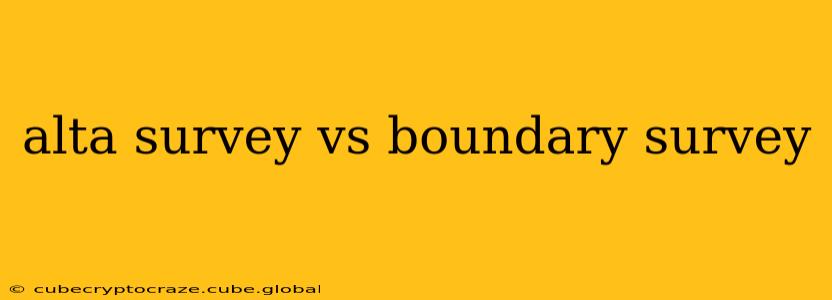Choosing the right type of land survey is crucial for various real estate transactions and construction projects. Two common types are Alta surveys and boundary surveys. While both involve determining property lines, they serve distinct purposes and have different levels of detail. This comprehensive guide will clarify the key differences between Alta surveys and boundary surveys, helping you understand which one is right for your needs.
What is an Alta Survey?
An Alta survey, also known as an ALTA/ACSM Land Title Survey, is a comprehensive land survey that goes beyond simply identifying property boundaries. It's specifically designed to meet the requirements of the American Land Title Association (ALTA) and the National Society of Professional Surveyors (NSPS). These surveys provide a detailed depiction of the property, including improvements, easements, encroachments, and other relevant features that impact the title insurance policy.
Key features of an Alta Survey:
- Comprehensive boundary determination: Accurately locates and defines property lines.
- Detailed mapping of improvements: Shows the location of buildings, structures, fences, and other improvements on the property.
- Identification of easements and encroachments: Clearly identifies any easements (rights of way) affecting the property and any encroachments (structures or features extending onto neighboring properties).
- Certification by a licensed surveyor: A licensed surveyor certifies the accuracy and completeness of the survey.
- Meets title insurance requirements: Satisfies the requirements of most title insurance companies, minimizing potential title issues during a real estate transaction.
What is a Boundary Survey?
A boundary survey focuses primarily on determining the precise location of the property lines. While it might include some details about improvements, its main objective is to establish the legal boundaries of the land. Boundary surveys are often less detailed than Alta surveys.
Key features of a Boundary Survey:
- Property line determination: The primary focus is on accurately locating and marking the property boundaries.
- Limited detail on improvements: May include some information on improvements, but generally less comprehensive than an Alta survey.
- May not identify easements or encroachments: While some boundary surveys may include this information, it's not always a standard inclusion.
- Certification by a licensed surveyor: Similar to Alta surveys, a licensed surveyor certifies the survey's accuracy.
Alta Survey vs. Boundary Survey: A Comparison Table
| Feature | Alta Survey | Boundary Survey |
|---|---|---|
| Purpose | Meet title insurance requirements; detailed property information | Primarily determine property boundaries |
| Detail | Highly detailed, comprehensive | Less detailed, focused on boundaries |
| Improvements | Detailed mapping of all improvements | Limited information on improvements |
| Easements | Clearly identifies easements and encroachments | May or may not identify easements/encroachments |
| Cost | Generally more expensive | Generally less expensive |
| Title Insurance | Typically required for title insurance | Not always required for title insurance |
What kind of survey do I need?
The choice between an Alta survey and a boundary survey depends on your specific needs.
-
Real Estate Transactions: An Alta survey is typically required by lenders and title insurance companies for most real estate transactions, especially commercial properties. It helps protect all parties involved by ensuring a clear understanding of the property boundaries and potential title issues.
-
Construction Projects: A boundary survey is often sufficient for construction projects where the primary need is to establish the property lines for building placement. An Alta survey might be necessary if the project involves boundary lines close to existing structures or easements.
-
Legal Disputes: Both types of surveys can be valuable in resolving boundary disputes. The level of detail required will depend on the complexity of the dispute.
What are the potential issues if I choose the wrong survey?
Choosing the wrong type of survey can lead to several issues:
-
Delayed or failed closing: In real estate transactions, a lack of a proper Alta survey can delay or prevent the closing process.
-
Legal disputes: Inaccurate boundary information can lead to costly legal disputes with neighbors.
-
Construction problems: Building on a neighbor's property due to inaccurate boundary information can result in expensive legal battles and demolition.
-
Higher insurance premiums: Title insurance companies may require additional surveys or charge higher premiums if the initial survey is insufficient.
How much does each type of survey cost?
The cost of a survey varies depending on several factors, including the size and location of the property, the complexity of the terrain, and the surveyor's fees. Alta surveys typically cost more than boundary surveys due to their greater detail and complexity. It's best to obtain quotes from multiple licensed surveyors in your area to compare prices.
This guide provides a general overview. Always consult with a licensed surveyor to determine the most appropriate type of survey for your specific situation. They can assess your needs and recommend the best course of action.
